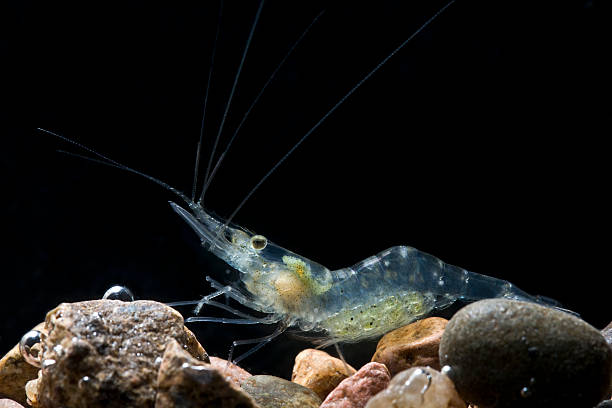Ghost Shrimp (Palaemonetes paludosus): The Transparent Guardians of Freshwater Habitats
Table of Contents
Scientific Classification
| Kingdom | Animalia |
| Phylum | Arthropoda |
| Class | Malacostraca |
| Order | Decapoda |
| Family | Palaemonidae |
| Genus | Palaemonetes |
| Species | P. paludosus |
| Scientific Name | Palaemonetes paludosus |
Description
The Ghost Shrimp, also known as Glass Shrimp, may be small, but they play a crucial role in freshwater ecosystems. These fascinating crustaceans earn their ghostly name from their transparent, glass-like bodies, which allow us to see their organs and digestion in action. It’s almost like getting a live anatomy lesson right before your eyes!
As adults, they typically measure around 1.25 to 1.75 inches in length. They sport a semi-hard exoskeleton and have a long rostrum that resembles a beak, extending from their head. Their bodies are segmented, and they come equipped with five pairs of walking legs and five pairs of swimming appendages, which they use with remarkable grace and precision.
While Ghost Shrimp might appear fragile, they are actually resilient little creatures. They play a vital role in aquatic food webs, serving as both scavengers and prey.
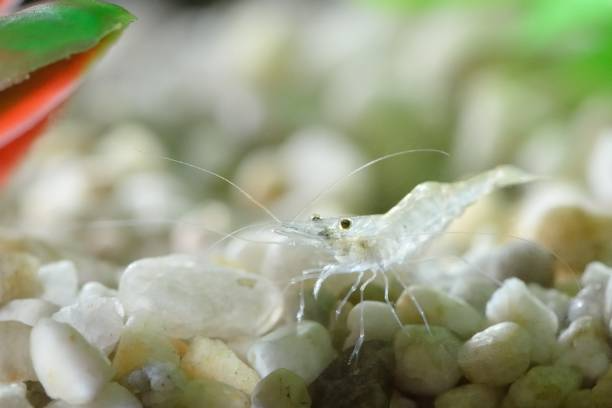
Distribution
Ghost Shrimp are originally from the southeastern United States, with Florida being their main stronghold. You can also find them in parts of Georgia, Alabama, Mississippi, Louisiana, and South Carolina.
They’ve made their way to other regions, often by hitching a ride through bait sales or being released from aquariums.
What sets Ghost Shrimp apart from other marine creatures, like Neotrypaea californiensis, is that they belong to different genera and thrive in distinct habitats.
Habitat
These shrimp love to hang out in calm, plant-filled freshwater areas, such as:
– Marshes and swamps
– Lakes teeming with aquatic plants
– Gentle rivers and streams
– Man-made ponds and canals
They really thrive in shallow waters where the substrate is soft and packed with organic matter. Aquatic plants like eelgrass and duckweed not only provide them with food but also offer great hiding spots. Their transparent bodies help them blend in with their environment, making it easier to evade predators.
Ghost Shrimp are also pretty adaptable, as they can tolerate slightly brackish water. This ability shows just how well they can adjust to different surroundings.
Diet
Ghost Shrimp are fascinating little creatures that eat just about anything! As omnivorous detritivores, they play a vital role in breaking down organic matter by munching on:
– Decaying plants and animals
– Algae
– Microorganisms
– Biofilm and periphyton
– Leftover fish food (when kept in tanks)
In aquariums, they act like natural cleaners. They scavenge around, using their tiny claws to pick up bits of debris. Their diet not only helps keep the water clean but also reduces algae growth, making them a fantastic addition to any aquarium ecosystem.
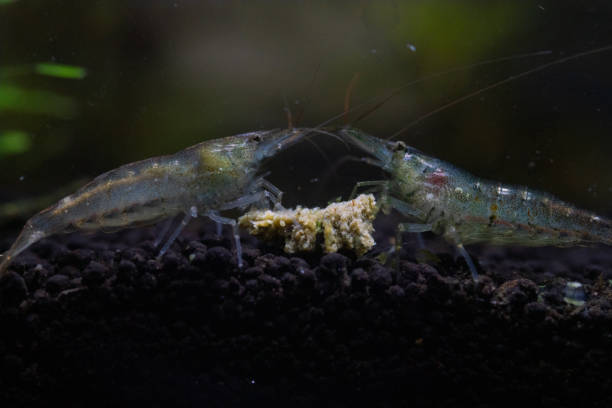
Behavior
Ghost Shrimp may be small, but they’re surprisingly hardworking little creatures. Here’s a glimpse into their daily lives:
– Foraging along the ocean floor
– Grooming themselves with their delicate appendages
– Quickly darting for cover when they feel threatened
These little guys are non-aggressive and quite peaceful, often found hanging out in small groups. Their movements are almost ghostly—swift and smooth, making them easy to miss until they suddenly zip away. They tend to be more active at night, taking advantage of the low light to forage more safely.
When it comes to communication, Ghost Shrimp mainly rely on touch and their positioning rather than visual cues or sounds.
Lifespan
In the wild, Ghost Shrimp typically have a lifespan of one to two years. However, this can change based on factors like their environment and the presence of predators. When kept in captivity and given proper care, they can live for about 18 to 24 months.
Several key factors can influence their lifespan, including:
– Clean, well-oxygenated water
– Stable temperatures ranging from 65 to 80°F (18 to 27°C)
– A varied diet
– The absence of aggressive tank mates
While their time on Earth is relatively short, they make up for it by reproducing quickly, which helps keep their population stable.
Reproduction and Lifecycle
Ghost shrimp have a fascinating way of reproducing. They engage in sexual reproduction, with clear distinctions between males and females. When breeding season rolls around, the males use chemical signals to find females that are ready to mate.
Depending on their size and overall health, females can carry anywhere from 20 to 80 eggs.
These eggs typically take about 2 to 3 weeks to hatch. During this crucial period, the females diligently fan the eggs to ensure they get enough oxygen and stay free from fungus. Once the eggs hatch, the tiny shrimp emerge as planktonic larvae. These larvae go through several developmental stages, molting multiple times before they finally grow into small adults.
Molting is a continuous process for them throughout their lives, which not only allows them to grow but also helps them regenerate their limbs.
Predators
- Because they’re quite small, Ghost Shrimp find themselves on the menu for a variety of predators. These include:
- – Small fish like bettas, guppies, and tetras
- – Aquatic amphibians such as frogs and newts
- – Birds like herons and kingfishers
- – Dragonfly larvae and other predatory insects
- – Larger crustaceans or aggressive tank mates when kept in captivity
- To stay safe from being eaten, they use a few clever tricks:
- – Camouflage through their transparent bodies
- – Quick, darting swimming motions
- – Hiding among plants and under rocks
Nest
Ghost Shrimp do not build traditional nests. Instead, the female’s body becomes the nursery. Eggs are held securely under her abdomen, attached to her swimmerets.
These shrimp look for safe spots when they molt or carry eggs. In aquariums, dense plant cover, caves, or sponge filters are ideal shelters. In the wild, they use submerged roots, plants, and leaf litter.
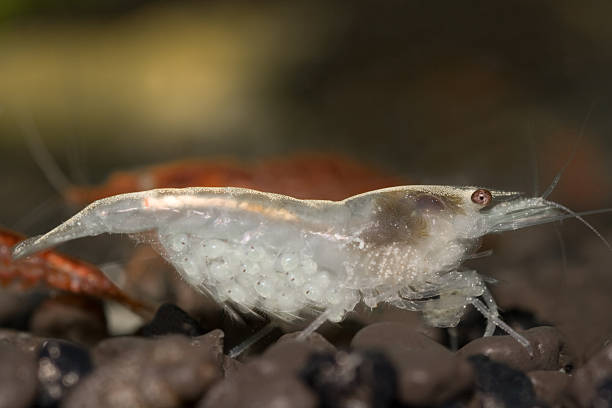
Adaptations
Despite their fragile appearance, Ghost Shrimp are finely tuned survivors. Key adaptations include:
- Transparency: Renders them nearly invisible, protecting them from visual predators.
- Molting: They shed their exoskeletons regularly, enabling growth and self-repair.
- Filter-feeding limbs: Their tiny claws and mouthparts help them pick up micro-debris efficiently.
- Oxygen efficiency: They can survive in low-oxygen areas, but they prefer well-aerated water.
- High fecundity: Compensates for their short life and high predation rate.
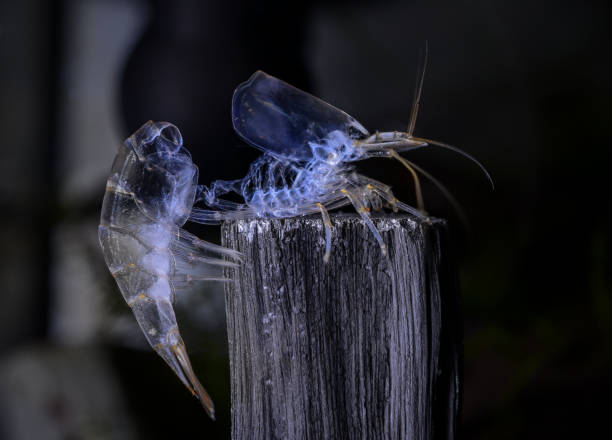
Mating Season
Ghost Shrimp usually breed in spring and summer. Warmer water makes them more active and triggers this behavior. In southern areas, reproduction can happen almost all year. This is especially true in indoor tanks or warm natural habitats.
In aquariums with steady temperatures and food, fish can breed on their own.
Breeding
Breeding Palaemonetes paludosus in captivity is both feasible and common. To encourage breeding:
- Maintain a stable temperature around 75°F (24°C)
- Keep water clean and free of toxins
- Provide plenty of plant cover
- Ensure a protein-rich diet for females
After the eggs hatch, larvae need infusoria or very fine planktonic food for the first few days. As they grow, they can be transitioned to crushed flakes, baby brine shrimp, and algae.
Breeding Ghost Shrimp is sustainable. It’s often done for pet stores, research, and to keep home aquariums healthy.
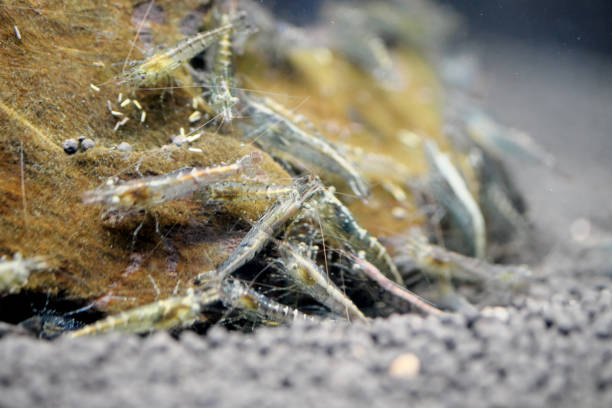
Interesting Facts
- Did you know some fascinating facts about living lab tools? These handy devices are a favorite among scientists because their transparent bodies allow researchers to closely observe how circulation and digestion work.
- Now, let’s talk about eco-cleaners. These little heroes help keep our ecosystems tidy, whether in the wild or in captivity. They munch on waste and help stop algae from taking over.
- And then there are rapid molters. These creatures shed their skin every few weeks, but during this vulnerable time, they tend to hide away to stay safe from predators.
- Another cool fact is about regeneration. They have the amazing ability to regrow lost limbs and antennae with each molt.
- Lastly, let’s not forget about sensitive indicators like Ghost Shrimp. They play a crucial role in testing for environmental toxicity, as they react strongly to pollutants and changes in water chemistry.

Conservation Status
Right now, Palaemonetes paludosus isn’t classified as threatened or endangered, and it doesn’t have any special conservation status. This is mainly because of a few key factors:
– It has a wide distribution
– It reproduces successfully
– It can adapt to various freshwater habitats
That said, like many aquatic creatures, it does face some indirect threats, including:
– Pollution and contamination of water
– Destruction of habitats, such as wetland draining and agricultural runoff
– The introduction of invasive predators
– Overharvesting for bait or the aquarium trade, although this is relatively minor
Maintaining healthy freshwater ecosystems is crucial for the survival of this small but important species.
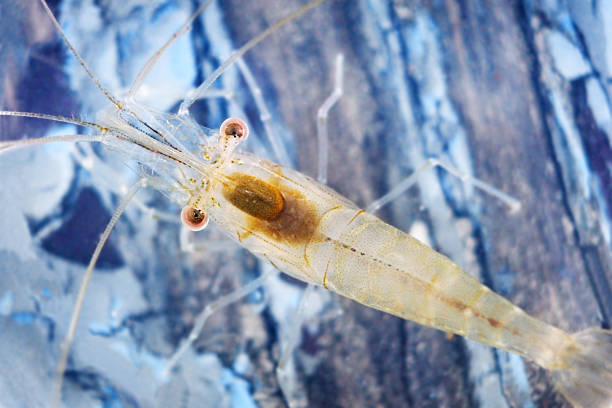
Conclusion
Ghost Shrimp may be small and easily overlooked, but they play a crucial role in freshwater ecosystems. These little guys are hard at work, cleaning up, recycling nutrients, and providing a food source for various aquatic creatures. Their efforts help maintain a healthy and balanced environment.
Palaemonetes paludosus showcases the small wonders of nature, whether found in a marsh or an aquarium. They are delicate, transparent, and incredibly important.
By taking the time to understand and appreciate these tiny beings, we not only honor the diversity of freshwater life but also develop a deeper respect for the roles that even the smallest organisms play in our world.


